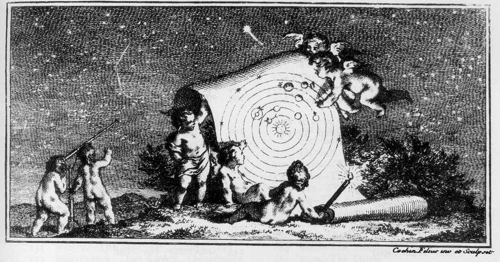|
|
Spiritual Meditations and Exercises Brotherhood of Light Lessons: Course Books on Astrology, Alchemy and Tarot
For Email Marketing you can trust
|
Astro-Tarot SeriesIntroduction: Astrological symbolism
|
|||||||||||||||||||||||||||||||||||||||||||||||
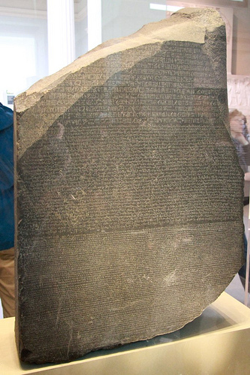 |
| Rosetta Stone |
Yet even in the short span of a few hundred years the characters used in writing English have so changed that the reading of Chaucer in the original script would be difficult for most of us. For nearly 2,000 years before the discovery, in 1799, of the Rosetta Stone, bearing parallel inscriptions in Greek, in Egyptian demotic characters, and in Egyptian hieroglyphics, that which the Egyptians so painstakingly had engraved on stone in hieroglyphics had been lost to the human race. Time makes sad havoc with arbitrary forms.
Yet even before the time of Egypt, and long before complex hieroglyphics came into use, men had put their thoughts into writing. Pictures of the aurochs, the European bison, were traced on the walls of their lairs by cave-men; perhaps not long after the last ice sheet receded from the region; and molded images of this and other game, with arrows piercing, have been found far back in the ceremonial crypts of their caverns.
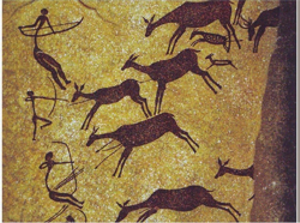 An image of a bison pierced with a spear, or a wild hog with a knife in its side, tells a story. It suggests also, in the light of what even at this date we know of primitive customs, that there were medicine men or witch doctors, who performed ceremonies in which the game to be hunted was killed in pantomime, that on the morrow it might, through, what now our New Thought friends would term, “Demonstrating,” be the more easily located, overhauled, and slain without accident to the hunters.
An image of a bison pierced with a spear, or a wild hog with a knife in its side, tells a story. It suggests also, in the light of what even at this date we know of primitive customs, that there were medicine men or witch doctors, who performed ceremonies in which the game to be hunted was killed in pantomime, that on the morrow it might, through, what now our New Thought friends would term, “Demonstrating,” be the more easily located, overhauled, and slain without accident to the hunters.
Yet a time came in the evolution of mankind when the Egyptians developed their hieroglyphic and demotic characters, the Maya of Guatemala developed other hieroglyphics, the Chinese invented their arbitrary symbols, and the inhabitants of Mesopotamia devised a method of writing by means of wedge-shape (cuneiform) imprints made on little bricks of adobe before these had dried; wedge-shaped because the papyrus stem they used for a stylus grows triangular. But before these times of using such arbitrary symbols men recorded their ideas as symbolical pictographs.
Peru, Mexico, Crete, China, Mesopotamia, India and Egypt—the seven chief colonies of Atlantis—each shows at its very beginning a rather high cultural development, such as entitles it to be called civilized. Not only some more or less arbitrary form of written language, but art, medicine, agriculture, astronomy, and political codes set each apart from adjacent savage people. Yet the early forms of more arbitrary writing mentioned were supplemented, at least where astrology and spiritual ideas were concerned, by the still older form, the characters of which probably were derived from ancient Atlantis.
This older form was made use of, for instance, by the American Indian, until he was induced to attend our modern schools and learn English. To represent good hunting, he painted or carved on a rock a picture of a mountain sheep or other game. To record a rabbit drive he drew the crude outline of a net into which grotesque hares were scampering. This was simple pictograph. It was effective up to a certain point; but was incapable of portraying philosophical ideas or opinions. For that purpose it became necessary to picture some object which would suggest by its common association, the thought the writer had in mind.
In our desert region the Indian artist, when he wished to indicate where a waterhole was located, would trace a line on a rock in that direction. He felt no need of picturing the water or the waterhole; for every Indian trail, in such a region, ends only at a waterhole. Where the line stopped this became the symbol of a waterhole; and in drawing such a line, he was using symbolical pictograph writing to indicate where other Indians might find relief from burning desert thirst. Such picture writing can be found throughout the western arid region all the way from Canada to Mexico.
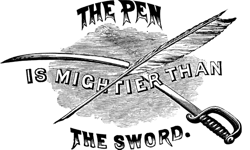 Or to come nearer home, when we say, “The pen is mightier than the sword,” we convey the idea that the written thought is superior to warfare. If this same idea were to be written in symbolical pictograph, it would present to view a broken sword lying beneath a pen. That is, to a people conversant with the common use of both sword and pen, the superiority of writing would immediately be apparent in the picture.
Or to come nearer home, when we say, “The pen is mightier than the sword,” we convey the idea that the written thought is superior to warfare. If this same idea were to be written in symbolical pictograph, it would present to view a broken sword lying beneath a pen. That is, to a people conversant with the common use of both sword and pen, the superiority of writing would immediately be apparent in the picture.
For such symbolical pictographs to be intelligible age after age, and thus not change their meaning markedly, as do more arbitrary forms of writing, the objects depicted must be such as readily to suggest, through their common associations, the thought it is wished to convey. That is, a balloon pictured among the constellations would have had no significance to ancient peoples; for they had had no experience with aeronautics. For that matter, the full significance of Sagittarius, Centaurus, Equulus, and Pegasus could not have been comprehended by American Indians before the landing of the Spaniards and the consequent introduction of horses. To get the complete meaning those who placed these figures in the sky sought to convey, one must be conversant with the use of a horse to carry its rider. Then the implication of the speed and carrying power of thought are suggested.
But the arrow which Sagittarius aims was well understood to them. And the Hopi Indians, in their ancient Calling Back the Sun ceremony, held exactly at the winter solstice when the Sun moves from Sagittarius into the earthy sign Capricorn, have their Thunderbird man, who was their Santa Claus before the Whites landed on our shores, snatch up arrows and throw them violently into a little mound of earth (Capricorn). That is, arrows, because their common associations are more widely recognized, are symbols more universal than are horses.
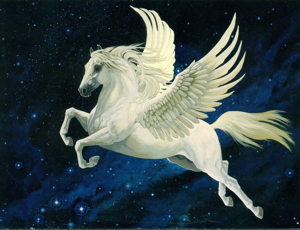 Yet if an Indian or other primitive man had been shown the symbolical pictograph by which the constellation Pegasus is portrayed in the sky he would have understood one portion of the conception perfectly. He would be familiar, through watching the flight of birds, with the idea that wings are used to carry their owners aloft. He would also be familiar with the thought of a higher, or spiritual realm, a Happy Hunting Ground, a region in which apparently he traveled in his sleep, and from which he brought back memories of those occurrences we call dreams. And thus would he largely have grasped the thought of contacting inner realms, which caused the Greeks to say that all poets, before they can attract the Muse, first must drink at the fountain created by a blow from the hoof of Pegasus.
Yet if an Indian or other primitive man had been shown the symbolical pictograph by which the constellation Pegasus is portrayed in the sky he would have understood one portion of the conception perfectly. He would be familiar, through watching the flight of birds, with the idea that wings are used to carry their owners aloft. He would also be familiar with the thought of a higher, or spiritual realm, a Happy Hunting Ground, a region in which apparently he traveled in his sleep, and from which he brought back memories of those occurrences we call dreams. And thus would he largely have grasped the thought of contacting inner realms, which caused the Greeks to say that all poets, before they can attract the Muse, first must drink at the fountain created by a blow from the hoof of Pegasus.
What I here am trying to emphasize is that the chief tenets of astrology have been handed down from a past so remote that those who passed this information on, either had no arbitrary form of written language, or such as they did have has long been lost in the inexorable changes wrought by passing time. Either because they had no other written form, or because they recognized the more permanent nature of such characters, therefore, they recorded such ideas as they left to us in the same language still employed by primitive people; in the language whose written characters are symbolical pictographs, and whose oral expression takes the form of myth and legend.
Nor is it unusual, even when more modern forms of writing come into use, for people to use the earlier types of language to convey their spiritual conceptions. The Roman Catholic religion still adheres to Latin, a language which has passed from common usage; and the Egyptians used hieroglyphics in practically all their religious writings, long after the adoption, for other purposes, of the far simpler forms.
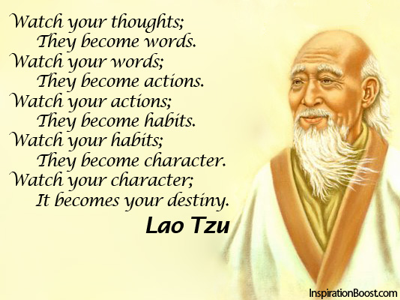 If we are intelligently to study what the ancients thought and taught, we must drop our assumption of mental superiority based merely on the fact that we use a different method of acquiring information and a different language in presenting it to others. We must be willing, not to accept their ideas merely because they taught them, but to test statistically, or at least scientifically in the modern way, what they taught in an effort to perceive how much is truth and how much they left is rubbish. And to know what they taught, and thus to know what to put to the test of modern scientific methods, we must learn the language which invariably they used to record their findings.
If we are intelligently to study what the ancients thought and taught, we must drop our assumption of mental superiority based merely on the fact that we use a different method of acquiring information and a different language in presenting it to others. We must be willing, not to accept their ideas merely because they taught them, but to test statistically, or at least scientifically in the modern way, what they taught in an effort to perceive how much is truth and how much they left is rubbish. And to know what they taught, and thus to know what to put to the test of modern scientific methods, we must learn the language which invariably they used to record their findings.
That is, we must be able to translate into plain straightforward English the symbolical pictographs which constitute the 48 constellations they traced in the sky, and the symbolical pictographs which constitute an additional commentary on the teachings of the 48 constellations, on the influence of the planets, on thoughts, and on people born under the various signs, which they inscribed on tarot cards.
And we must not entirely overlook what has been recorded orally. The myths and legends and folklore of the various peoples of the world often are very interesting as stories. But in addition to their entertainment value, which has been given to them to insure that they shall be perpetuated, they also, quite as much as pictures drawn upon a rock, convey ideas of more serious import.
Either pictures or stories may have a certain attractiveness of form; but pictures are not drawn, in the sky or on rocks, nor are stories perpetuated, by primitive peoples except they are employed to give expression through pictograph or universal symbolism to important thoughts which there is a desire to convey to other minds.
Because each card of the tarot was designed to depict in more detail, the significance of some astrological principle, including the signs, decanates and planets, it would be interesting if we knew exactly where the Stellar Wisdom which they portray first was practiced. We know that in forms which are but modifications of an identical original, it was present at the very beginning of the seven mentioned ancient centers of civilization. And experience proves that wherever a particular biological form, or a culture having many complex yet identical interrelating factors, is present in different areas of the world, it had its origin in a single region of dispersal. The inference, therefore, is that the symbolical pictographs of both the constellations and the tarot, as well as much important myth and legend, were carried from Atlantis to various regions of the earth before that ill-fated continent sank.
The value and correctness of the ideas left by ancient minds, as recorded in the constellations and on the tarot cards, should never be taken for granted. They should be subjected to the strictest tests. Yet in view of the fact that most of the astrological precepts thus handed down have stood the severe tests of practical application, and are found sound by modern astrological practitioners, it would seem that other of their ideas well warrant thorough examination. After all, they were specialists, not in mechanics and invention, as are modern men, nor even in art and literature as were the Greeks, but in determining the relation between the soul and the stars; between the influences of signs and planets and the things of the earth. For thousands of generations specially gifted men were set apart to devote their entire lives exclusively to such research.
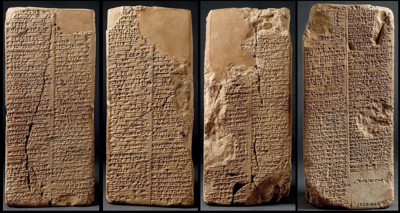 The Anu Enlil Series of Chaldea, for instance, which recorded both the positions in the heavens and the coincident events which happened on the earth in an effort to correlate these factors, extended unbroken for over a thousand years.
The Anu Enlil Series of Chaldea, for instance, which recorded both the positions in the heavens and the coincident events which happened on the earth in an effort to correlate these factors, extended unbroken for over a thousand years.
It is from these Chaldeans we derive the pictures of the constellations. Modern maps of the sky have many more than 48 constellations, because with the study of modern astronomy, kings and notables desired something placed in the heavens to remember them by, and the astronomers, who were dependent for livelihood upon such patronage, were accommodating. But the Greeks visited Chaldea and brought home the celestial sphere of the Chaldeans. And these old Greek sources show only 48 constellations, each describing, in characters of symbolical pictograph, one of the 12 signs, or one of the 36 decanates into which the Chaldeans divided their zodiac.
To give more details in reference to astrological principles and the spiritual science which they ever linked to these principles, the ancients had recourse to plates containing other descriptions also written in symbolical pictograph. That is, having traced in stars of light above the broader principles of that which they had learned they sought, and found in the tarot pictures, a medium for supplementing the amount of knowledge to be conveyed to following generations.
To make clear what I mean let us briefly consider, say, the symbols used for Mars, and the picture used for the constellation Virgo:

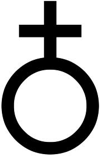 The symbol of Mars, as it has come down to us, shows either the cross of earth, or the spear of aggression, above and dominating the circle of spirit. This portrays well enough that a warlike spirit, or passions and gross appetites, prevail over the finer nature when Mars has unbridled sway; but it does not convey the almost equally important information that, as we have now determined statistically, Mars is responsible for more accidents than any other planet. Yet this is portrayed clearly in the Mars tarot, Arcanum XVI, where lightning striking the top of a pyramid smashes it and hurls two men to the earth.
The symbol of Mars, as it has come down to us, shows either the cross of earth, or the spear of aggression, above and dominating the circle of spirit. This portrays well enough that a warlike spirit, or passions and gross appetites, prevail over the finer nature when Mars has unbridled sway; but it does not convey the almost equally important information that, as we have now determined statistically, Mars is responsible for more accidents than any other planet. Yet this is portrayed clearly in the Mars tarot, Arcanum XVI, where lightning striking the top of a pyramid smashes it and hurls two men to the earth.
 The constellation Virgo, picturing the sign, is represented by a woman who holds a palm frond in one hand and ears of wheat in the other. This suggests the raising of crops and their harvest, and the Tree of Good and Evil which grew in the Garden of Eden which attracted Eve. And if we know the Bible story in which through yielding to Eve’s temptation, man was condemned to live by the sweat of his brow, it links the sign up with the house of labor, which in a natural chart it rules.
The constellation Virgo, picturing the sign, is represented by a woman who holds a palm frond in one hand and ears of wheat in the other. This suggests the raising of crops and their harvest, and the Tree of Good and Evil which grew in the Garden of Eden which attracted Eve. And if we know the Bible story in which through yielding to Eve’s temptation, man was condemned to live by the sweat of his brow, it links the sign up with the house of labor, which in a natural chart it rules.
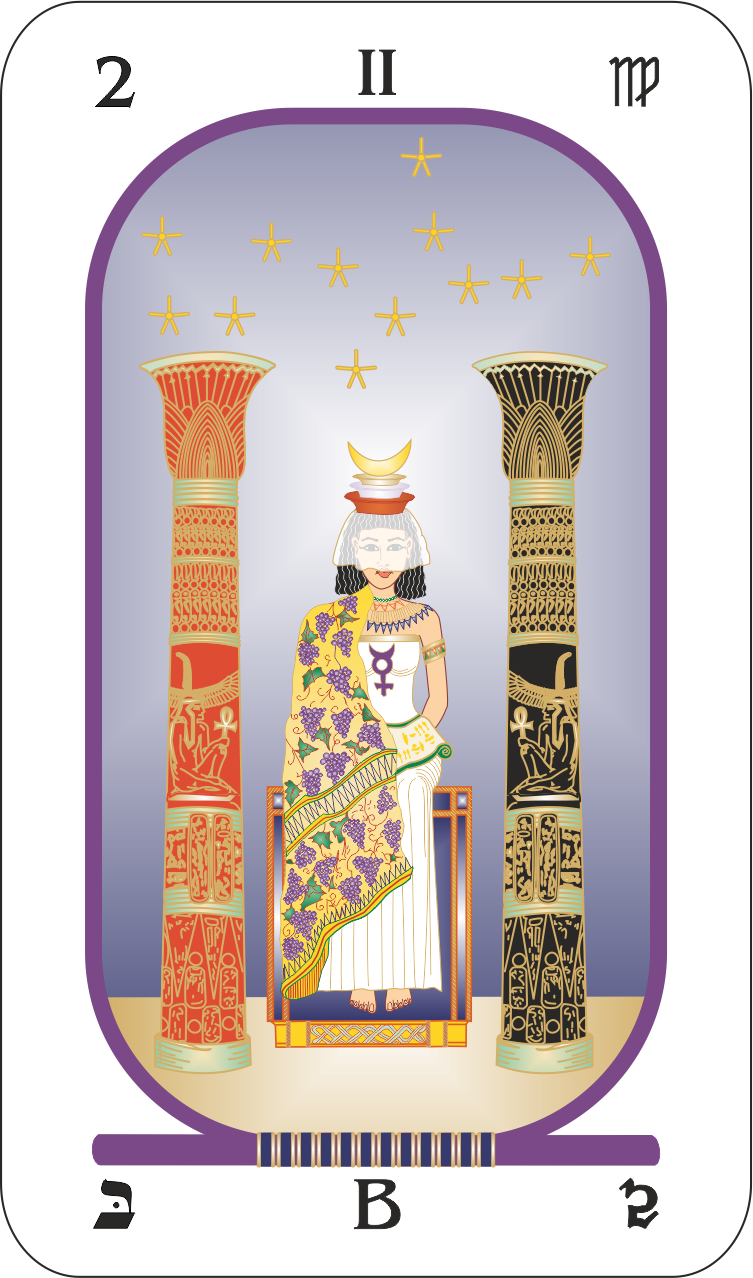 All that the constellation pictures is true enough; but if we now turn to the Virgo tarot card, Arcanum II, showing a woman seated at the Temple of Isis, crowned with a tiara of three stories, and on her knees an open book which she half covers with her mantle, and the symbol of Mercury upon her bosom; we find emphasized that this is a mental sign, that objective consciousness perceives only the external side of truth, that thought determines on each of the three planes of existence the level occupied by the person, and much information on how to acquire a mental harvest of value.
All that the constellation pictures is true enough; but if we now turn to the Virgo tarot card, Arcanum II, showing a woman seated at the Temple of Isis, crowned with a tiara of three stories, and on her knees an open book which she half covers with her mantle, and the symbol of Mercury upon her bosom; we find emphasized that this is a mental sign, that objective consciousness perceives only the external side of truth, that thought determines on each of the three planes of existence the level occupied by the person, and much information on how to acquire a mental harvest of value.
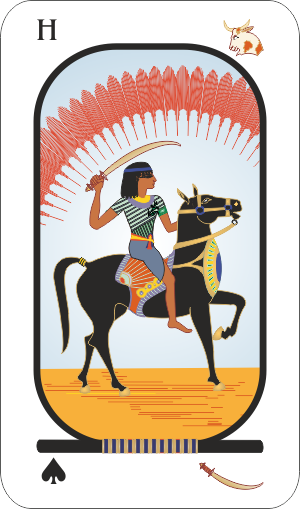 Later generations not only added new constellations to the sky to honor their kings and nobles, but they also altered the tarot pictures to conform to their religious conceptions and their mode of life. To indicate more clearly what I mean, consider that on one of the best English packs the horseman of swords is an armored crusader, dashing across the frontier into another’s domain in the well known effort to spread enlightenment by means of the sword. The picture instantly suggests the conquest of far-flung empire and the forceful dissemination of Christian creeds among the benighted heathens thus conquered.
Later generations not only added new constellations to the sky to honor their kings and nobles, but they also altered the tarot pictures to conform to their religious conceptions and their mode of life. To indicate more clearly what I mean, consider that on one of the best English packs the horseman of swords is an armored crusader, dashing across the frontier into another’s domain in the well known effort to spread enlightenment by means of the sword. The picture instantly suggests the conquest of far-flung empire and the forceful dissemination of Christian creeds among the benighted heathens thus conquered.
Or consider that the Jews believed that they were a chosen people; that Jehovah was a God of favoritism who could be cajoled into granting unmerited rewards to those who gained His good graces. Christianity inherited the same idea; and therefore in many Christian tarot packs, we find justice, not blindfolded, as the Egyptian pack portrays because Egyptian initiates believed justice to be the operation of an undeviating natural law; but with her eyes wide open to bribe and prejudice.
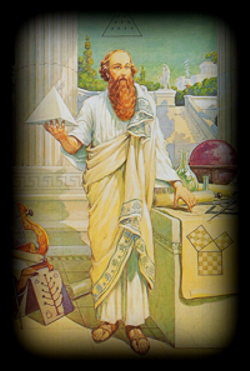 As in the case of the constellations, if we wish to know what the ancient initiates intended to convey through the tarot, we must go back to a time when astrology was looked upon with favor. And fortunately, just as the Chaldean constellations were correctly preserved by the Greeks, so also a Greek, Iamblichus, a Neo-platonist of the fourth century, has preserved for us in a document entitled, An Egyptian Initiation, an accurate description of each of the old Egyptian tarot pictures.
As in the case of the constellations, if we wish to know what the ancient initiates intended to convey through the tarot, we must go back to a time when astrology was looked upon with favor. And fortunately, just as the Chaldean constellations were correctly preserved by the Greeks, so also a Greek, Iamblichus, a Neo-platonist of the fourth century, has preserved for us in a document entitled, An Egyptian Initiation, an accurate description of each of the old Egyptian tarot pictures.
These tarot pictures were frescoed on the walls of an ancient Egyptian initiation chamber, and The Brotherhood of Light Egyptian Tarot cards were designed painstaking to preserve, in every detail, the pictures exactly as described by him. The Egyptian tarot pack in its symbolical pictographs thus accurately portrays the Stellar Wisdom as it was understood by Egyptian initiates. And these, as well as the Chaldeans, were thoroughly conversant with astrology.
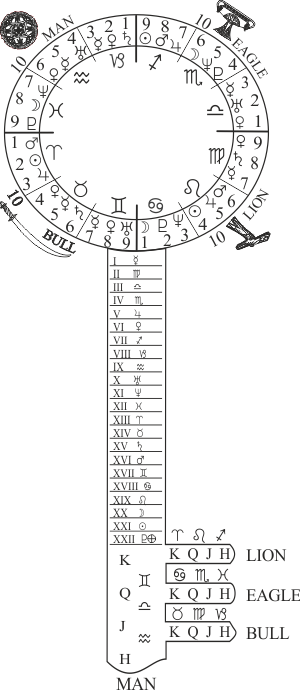 Signs and planets — Of chief importance in astrology are the influences of the 10 planets and 12 zodiacal signs. Therefore, to describe these influences those who designed the tarot drew 22 more complex symbolical pictographs; one to explain each planet and one to explain each sign. These constitute the 22 Major, or more important, Arcana. Arcanum means a mystery; and the tarot cards are called Arcana because they explain the astrological influences, without a knowledge of which the cause of most of the conditions and happenings of life remain a mystery.
Signs and planets — Of chief importance in astrology are the influences of the 10 planets and 12 zodiacal signs. Therefore, to describe these influences those who designed the tarot drew 22 more complex symbolical pictographs; one to explain each planet and one to explain each sign. These constitute the 22 Major, or more important, Arcana. Arcanum means a mystery; and the tarot cards are called Arcana because they explain the astrological influences, without a knowledge of which the cause of most of the conditions and happenings of life remain a mystery.
Decanates — The signs of the zodiac are divided into three sections of 10 degrees each, called decanates, and having each its own distinctive influence. As there are 12 signs this gives 36 decanates; therefore to describe their significance, which is not so important as that of planets and signs, the ancients designed 36 less complex symbolical pictographs, which are known as the Minor Arcana of the tarot.
Triplicity — There are 9 decanates in the zodiac belonging to each of four triplicities; and on the Minor Arcana describing their influence the triplicity to which the decanate belongs is indicated by its suit. But these astrological principles of fire, water, air and earth were deemed of sufficient importance by the ancients that they designed a Minor Arcanum No. 10 for each of the four suits to explain them. Thus, even as in modern playing cards, which were derived from them, there are a total of 40 Minor Arcana.
Aspects — The astrological aspects are classified as harmonious or discordant. Unlike playing cards, the tarots have a top and a bottom; and when a card is right way up it signifies that the influence is as favorable as if the astrological factor received a harmonious aspect; but when the card is reversed it signifies the influence is to be considered as if the astrological factor received a discordant aspect.
Houses — Houses, which in a birth chart indicate the departments of life affected by the influences are not given separate characters in the tarot; but are signified by the Spread; that is, by the manner in which the cards are placed in giving a reading.
People — Because what happened to people and the influence upon their characters and lives of astrological forces, was of paramount importance to those who designed the tarot, as they are to astrologers of this day; they devoted one card to explaining the character and probable activities of persons born under each zodiacal sign. Some of these are pictured as men and women. A card representing a woman when reversed signifies a man, and a card representing a man when reversed denotes a woman. These constitute 12 of the Court Arcana, corresponding to the face cards in the common playing pack.
Thoughts—But astrological energies also have an influence over people’s thoughts; and the type of thinking thus stimulated was considered by these Wise Men of the East to be of vast importance. Therefore, they explained the influence of each of the four types of thinking—about business and honor, about affections and the home, about money and health, and about war and strife—by a separate card, which because it depicts a human figure on a horse is also classified as a Court Arcanum. In addition to the 12 face cards of the common pack, the tarot has four horsemen, or 16 Court Arcana in all.
The complete pack of cards, each Egyptian tarot explaining in the language of symbolical pictograph some vital astrological information, contains 22 Major Arcana, 40 Minor Arcana, and 16 Court Arcana; or 78 explanatory designs in all.
(This concludes part 1 of 23)
To purchase The Sacred Tarot by C. C. Zain (student format, hardbound)
To purchase The Egyptian Tarot Cards
Back to Classic Elbert Benjamine
Copyright 2015 The Church of Light
|
||||||||
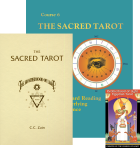 The Sacred Tarot |
Horoscope Software Hermetic Astrology |
Articles and Papers by Elbert Benjamine |
 History of the Adepts, Spiritual Ancestors of The Brotherhood of Light Lessons |
Global Astrology Forecasts and Reports |
Additional Articles, Reports, History, Data |
Order of the Sphinx Research |
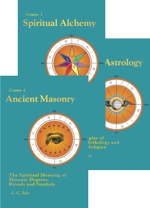 Brotherhood of Light 21 Courses eBooks PDF Downloads Kindle iPad, iPhone & Android |
|
Copyright © 2025 All Rights Reserved |
The Church Of Light (USA) 501(c)(3) organization Phone: 800-500-0453 / 505-247-1338 Fax: 505-814-7318 / Email: churchoflight@light.org Privacy Policy | Shipping & Returns Policy | Contact Us |





